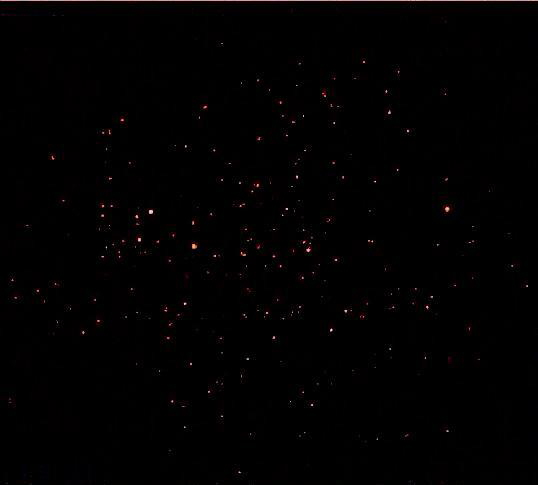|
Stellarium: 5 ft. diameter, Scale = 2.25 in/parsec. Radius of mapped space = 13.33 parsecs.
Exposure: 3 sec @ f /5.6, asa 400, Distance = 8.5 ft to window, 11 ft to map center.
No existing technology can duplicate the appearance of a Stellarium. It is a real 3 dimensional object, not “virtual” and not an “effect.”
 The stars in a Stellarium are strikingly realistic. They are tiny bright points of light. Photographs makes stars look brighter by making the circles of light larger, but real stars are so distant that the human eye cannot see a disk. Even the largest and closest stars are points of light too small for the human eye to resolve. The stars in a Stellarium are strikingly realistic. They are tiny bright points of light. Photographs makes stars look brighter by making the circles of light larger, but real stars are so distant that the human eye cannot see a disk. Even the largest and closest stars are points of light too small for the human eye to resolve.
The stars in a Stellarium work the same way. Nearly all of the brightness variation is the result of more actual light coming from a point less than .25 mm (.01 inch) in diameter. That is close to the resolving power of our eyes at typical viewing distances. A Stellarium achieves uncanny realism because we perceive the Stellarium stars and real stars the same way.
Most nearby stars are too dim to be seen with our unaided eyes. When we look up at night the majority of the stars we see are much brighter than average. They are not our closest neighbors in space but more distant, brilliant objects.
In a Stellarium the nearby stars are brightened up enough to be visible. The range of actual star luminosity (the absolute visual magnitude) is compressed to fit into the range of human vision. The technique, known as magnitude compression, is widely used in planetarium star projectors so that the brightest stars are not large circles of light in the planetarium’s artificial sky.
Stellarium star colors are determined by the spectral type of each star. Since our color perception is reduced at low light levels the star colors are slightly exaggerated.
Many stars are members of multiple star systems, with two or more stars orbiting each other. A telescope is required to see the individual stars in such a system. A Stellarium shows each star of multiple systems with the separation between the members exaggerated enough to be seen. The appearance is frequently like that one would see in a small telescope.
The view one sees when looking into a Stellarium is like one might expect if he were many light years away from our solar system and looking back toward it. The sun is at the center. The Earth and other planets would be far too dim, tiny, and close to the sun to be visible. And the viewers eyes have the power of large telescopes separated by several light years for full stereoscopic 3D vision.
Landmark stars and our sun are identified by small LED lamps mounted inside of the map. We can supply a push button control panel for these ID markers, or the customer may choose to supply his own panel or an automated control system.
|

